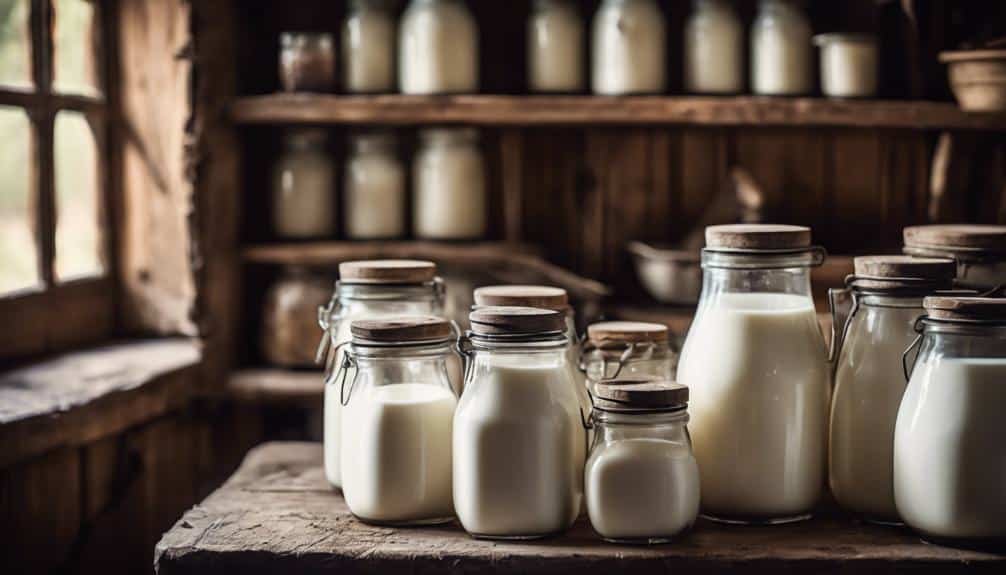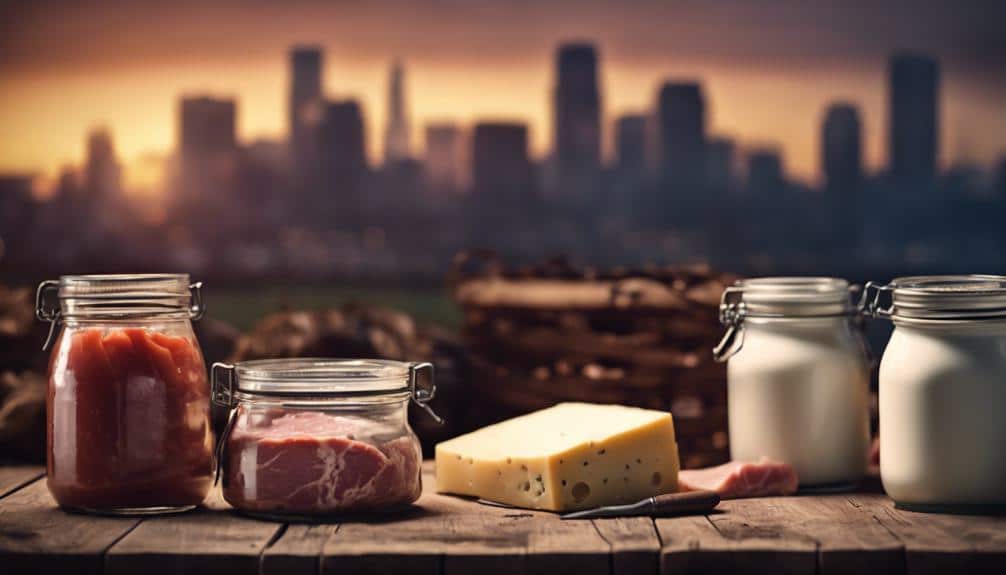To safeguard meat from urban livestock, try freezing, vacuum sealing, or canning to guarantee safety and longevity. Freezing halts bacterial growth while vacuum sealing prevents oxidation. Canning meat involves cooking it and sealing it in sterile containers.
For dairy, pasteurization or ultra-pasteurization kills bacteria, extending shelf life greatly. Fermenting milk into products like yogurt or kefir adds probiotics and extends freshness. Traditional preservation methods like salting, smoking, or drying meat can also be very effective, adding flavor while inhibiting bacteria.
While you preserve meat and diary produce in your homestead knowing how to ferment foods your own can be an added advantage for your journey to self-sustain lifestyle. And if you grow grains on your urban garden this article may come handy to learn how you can store grain in the right way.
Why is meat preservation important?

Preserving meat is essential because it extends the shelf life of your urban livestock products, guaranteeing you have a reliable food source. By mastering preservation techniques, you’re not just storing food; you’re securing your independence and self-sufficiency. Properly preserved meat maintains its nutritional value, keeping essential proteins and vitamins intact. This isn’t just about survival; it’s about thriving on quality, nutritious food that supports your health and lifestyle.
Moreover, preserving your meat correctly ensures that the flavor is maintained. You’ll want your hard-earned produce to taste as good months from now as it does today. Flavor maintenance is key to enjoying your meals and staying motivated to continue your urban farming efforts.
Adhering to safety standards is also critical. You need to know your food is safe to eat, free from harmful bacteria and pathogens. Implementing tried-and-true preservation methods not only extends the shelf life but also guarantees that the food you consume is safe, giving you peace of mind.
In preserving your meat, you’re not just making food last longer; you’re taking a significant step towards self-reliance and ensuring that your urban livestock endeavor is sustainable and fruitful. This is freedom at its most fundamental, right on your plate.
Local methods of preserving meat
You might be wondering how supermarkets manage to keep their meat fresh for so long or how you can preserve meat in your own home without using electricity.
We’ll explore methods that avoid chemical preservatives, ensuring your meat stays safe and natural.
Understanding these techniques can help you maintain a sustainable food source right from your urban livestock.
How do supermarkets preserve meat?
Supermarkets utilize various techniques to guarantee that meat remains fresh and safe for consumption. They’ve engineered supermarket cooling systems to maintain ideal temperatures, important for preventing bacterial growth. Additionally, packaging innovations such as vacuum sealing and modified atmosphere packaging help in extending the shelf life of meats. Finally, inventory rotation practices ensure that older stock is sold before newer deliveries, minimizing waste and ensuring freshness.
| Technique | Description | Benefit |
|---|---|---|
| Cooling Systems | Maintains low temperatures | Prevents bacterial growth |
| Packaging Innovations | Vacuum sealing, modified atmospheres | Extends shelf life |
| Inventory Rotation | Sells older stock first | Ensures freshness, reduces waste |
You’re empowered to choose wisely, knowing these methods bolster the integrity of the meats you enjoy.
How to preserve meat for a long time?
Several local methods can help you preserve meat effectively for extended periods. Freezing techniques are your first line of defense. You’ll want to freeze your meat as soon as possible after processing, keeping it at temperatures that stop bacterial growth dead in its tracks.
Vacuum sealing is another fantastic option; it removes air from the packaging, greatly extending the meat’s shelf life by preventing oxidation and moisture loss.
Finally, canning processes allow you to store cooked meat in sealed containers that are then heated to kill any bacteria, ensuring the meat stays safe for months, or even years.
These methods provide you with the freedom to enjoy your livestock’s bounty long after the initial processing.
How to preserve meat without electricity?
When electricity isn’t an option, traditional methods like salting, smoking, and drying become essential for preserving meat. You can take matters into your own hands by using solar dehydrators, which harness the sun’s energy to dry meat efficiently. This method not only cuts your reliance on modern appliances but also maintains the nutritional value of your food.
Salt curing is another reliable technique; it involves rubbing salt on the meat to draw out moisture, creating an environment where bacteria can’t thrive. Alternatively, if you’re in a colder region, ice cellars can be a game-changer. These underground storage spaces keep meat frozen naturally, using the earth’s insulation.
Each method offers you the freedom to preserve meat sustainably, without needing power.
Chemicals are used in meat preservation
Important methods of preserving meat often involve the use of chemicals such as nitrates and salt to prevent spoilage and maintain flavor. You’ll find that these traditional practices reflect a deep-rooted cultural wisdom, but they also introduce preservation risks associated with chemical usage.
Despite concerns, the addition of natural antioxidants to your preservation process can mitigate some of these risks. These substances, found in spices or plant extracts, help maintain meat quality and extend shelf life without compromising your independence in choosing healthier options.
It’s vital to weigh the benefits against potential health impacts, ensuring you’re informed about what goes into your food. Embrace these methods responsibly, always aligned with your personal values and cultural practices.
How to preserve meat without chemicals
You can naturally preserve meat using age-old techniques like smoking, drying, or fermenting, which eliminate the need for chemical additives. These ancient techniques embrace your freedom to use natural processes, ensuring that your meat remains wholesome and tasty without relying on modern chemical preservatives. Let’s dive deeper into a few effective methods:
| Method | Description | Duration |
|---|---|---|
| Smoking | Exposes meat to smoke from burning wood, adding flavor and extending shelf life. | Several hours to days |
| Salt Curing | Involves coating meat in salt to draw out moisture, inhibiting bacterial growth. | Weeks to months |
| Drying | Meat is dehydrated using air or low heat, concentrating flavor and preventing spoilage. | Days to weeks |
Each method highlights a commitment to preserving your food in a way that’s as free from artificial intervention as the air you breathe.
Red meat preservation techniques
To effectively preserve red meat, consider techniques like curing, smoking, and freezing. Curing involves treating the meat with curing salt applications, which not only enhance flavor but also inhibit bacterial growth.
You’ll want to mix the right proportion of curing salts and spices, typically a ratio that suits your taste and safety guidelines. Apply this mixture thoroughly to every inch of the meat.
Vacuum sealing benefits your curing process by locking in flavor and extending shelf life greatly. By removing air, you’re preventing the growth of aerobic bacteria and molds.
Smoke flavoring techniques add a unique touch while offering an additional layer of preservation. The smoke imparts aromatic compounds that are antimicrobial.
You can choose from various woods like hickory or apple, each providing a distinct flavor. Smoking should be done at controlled temperatures to make sure the meat is both safe and deliciously infused.
Freezing is your go-to for long-term storage. Freeze your meat promptly after processing to maintain its quality. Use airtight containers or heavy-duty freezer bags to prevent freezer burn.
Milk preserving methods

Exploring milk preservation effectively requires understanding various methods such as pasteurization, refrigeration, and fermentation. You’ll find that each technique offers unique benefits, whether you’re aiming to extend shelf life or enhance flavor.
One robust method is ultra pasteurization. This process heats milk to a high temperature for a short period, killing more bacteria than regular pasteurization and giving milk an even longer shelf life without refrigeration. It’s perfect if you’re looking to stock up and minimize frequent shopping trips.
Freeze drying is another excellent option. By freezing the milk and then removing moisture under a vacuum, you’re left with a powder that retains much of the original flavor and nutrients. You can store this powder for months or even years. When you’re ready, just rehydrate it with water, and you’ve got fresh milk ready to go.
Lactose fermentation, such as making kefir or yogurt, not only preserves the milk but also can make it easier to digest. These fermented products bring a tangy zest to your meals and offer added probiotic benefits.
Frequently Asked Questions
What Are the Legal Regulations for Urban Livestock in Cities?
You’ll need to check local zoning restrictions, permit requirements, and noise ordinances to legally keep urban livestock. These rules guarantee your freedom doesn’t infringe on others’ rights while maintaining city order.
How Does Climate Affect Urban Livestock Meat Preservation?
You’ll find that temperature fluctuations and humidity control critically impact meat preservation. Seasonal adaptations are necessary to guarantee your efforts aren’t in vain, maximizing the freedom to sustainably manage food resources all year round.
Are There Any Health Risks From Consuming Urban Livestock Products?
Yes, consuming urban livestock products can pose health risks like disease transmission, chemical exposure, and nutritional differences. You should understand these risks to make informed choices about your food freedom.
What Are the Start-Up Costs for Urban Livestock Farming?
You’ll face initial costs in space utilization, securing feed, and overcoming breeding challenges. Embrace your freedom to innovate and efficiently manage resources to kickstart your urban livestock farming venture successfully.
Can Urban Livestock Activities Impact Local Biodiversity?
Yes, urban livestock activities can impact local biodiversity, leading to species displacement, habitat fragmentation, and pollinator decline. You’ll need freedom to innovate solutions that protect nature while promoting urban farming benefits.
